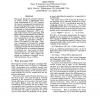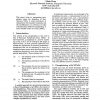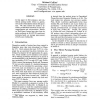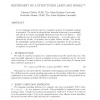ACL
1997
14 years 6 days ago
1997
Our goal is to identify the features that predict the occurrence and placement of discourse cues in tutorial explanations in order to aid in the automatic generation of explanatio...
ACL
1997
14 years 6 days ago
1997
ACL
1997
14 years 6 days ago
1997
This paper presents a partial solution to a component of the problem of lexical choice: choosing the synonym most typical, or expected, in context. We apply a new statistical appr...
ACL
1997
14 years 6 days ago
1997
This paper looks at representing paraphrases using the formalism of Synchronous TAGs; it looks particularly at comparisons with machine translation and the modifications it is nec...
ACL
1997
14 years 6 days ago
1997
Verbal and compositional lexical aspect provide the underlying temporal structure of events. Knowledge of lexical aspect, e.g., (a)telicity, is therefore required for interpreting...
ACL
1997
14 years 6 days ago
1997
We compare four similarity-based estimation methods against back-off and maximum-likelihood estimation methods on a pseudo-word sense disambiguation task in which we controlled f...
ACL
1997
14 years 6 days ago
1997
We describe a formal framework for interpretation of words and compounds in a discourse context which integrates a symbolic lexicon/grammar, word-sense probabilities, and a pragma...
ACL
1997
14 years 6 days ago
1997
In this paper we first propose a new statistical parsing model, which is a generative model of lexicalised context-free grammar. We then extend the model to include a probabilisti...
ACL
1997
14 years 6 days ago
1997
In this paper, we argue for the need to distinguish between task and dialogue initiatives, and present a model for tracking shifts in both types of initiatives in dialogue interac...
ACL
1997
14 years 6 days ago
1997
A new language model for speech recognition inspired by linguistic analysis is presented. The model develops hidden hierarchical structure incrementally and uses it to extract mea...




